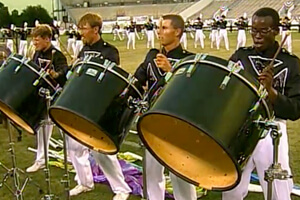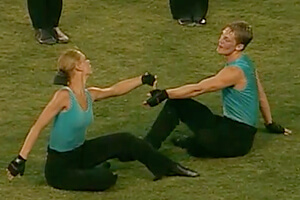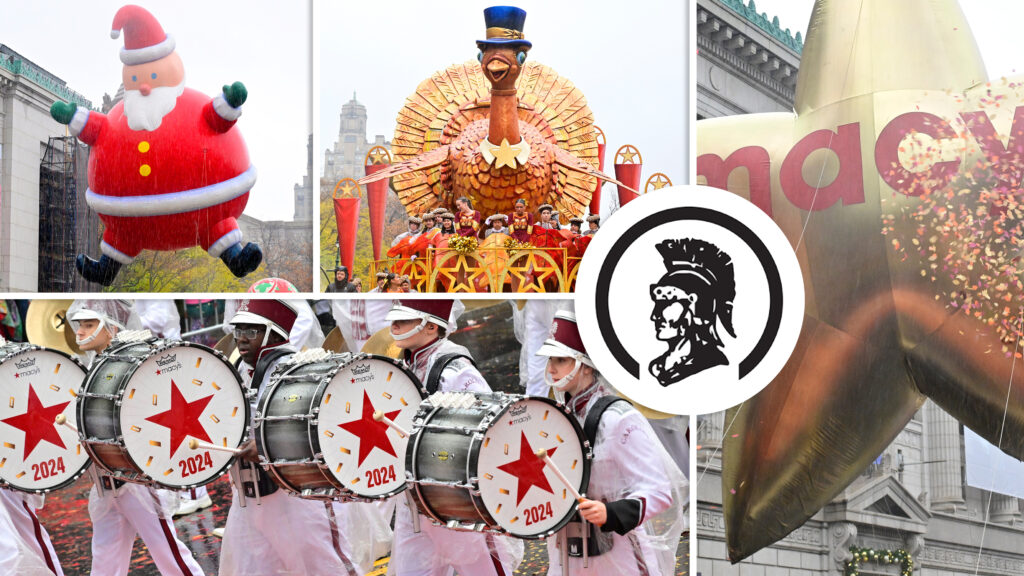
1998 Crossmen
Orlando’s Citrus Bowl Stadium witnessed quite a bit of excitement during the 1998 DCI World Championships. Blue Devils won the Quarterfinals competition, then slipped to a tie with Santa Clara Vanguard for 2nd in Semifinals under the Cadets, then slipped to 3rd in Finals under the Cadets and Vanguard. The Cavaliers, in 4th place, celebrated their 50th anniversary. Glassmen placed 5th for the first of three seasons over four years, marking the corps’ highest placement ever. DCI World Class audiences had earlier been introduced to the music of Pat Metheny when Cavaliers played “Ozark” in 1984 and Blue Devils performed “First Circle” in 1985. Metheny, winner of 20 Grammy Awards, created his first commercial recording in 1974 while still a student at Berklee College of Music, the famed Boston jazz hotbed that has produced 99 alums who have received Grammies. By 1995, he was performing with famed jazz vibist Gary Burton, with whom he had studied at Berklee. His earlier albums had a distinctive Latin influence, with later albums delving increasingly into a more contemporary vein, mixing jazz idioms a rock style that became known as jazz fusion. Metheny’s recording history brought him into contact with many of the world’s leading jazz artists, but it was his 1977 creation of the Pat Metheny Group¬—when he teamed up with jazz pianist and composer Lyle Mays—that turned him into a stunning commercial success. Metheny and Mays would collaborate for more than two dozen years and with the Pat Metheny Group, would share 10 of the 20 Grammy Awards that Metheny has won thus far, the fifth most by any group. Metheny has also won Grammy Awards in the most number of categories of any artist; with his 20 awards spread over seven categories. It wasn’t until 1991, however, that another DCI finalist corps performed Metheny when the Crossmen brought “A Pat Metheny Suite” to the football field comprised of “Minuano,” “Dream of the Return” and “Third Wind.” Seven years later in 1998, Crossmen performed a show titled “A Metheny Portrait,” which included three works some have referred to as the composer’s “Brazilian Trilogy,” due to a heavy use of Brazilian jazz and percussion. The three works were each from albums that won Grammy Awards for Best Jazz Fusion Performance. Crossmen’s show began with a blasting fanfare based on the theme of “Third Wind,” co-composed with Lyle Mays for the 1987 “Still Life (Talking)” album, the recording that gave the corps “Minuano” in 1991. A heavy use of wordless vocals mimicked the melody line, a Metheny staple. In this piece, Metheny explored the use of a guitar synthesizer, which made his guitar kind of sound like a trumpet.

1998 Crossmen
For this week only, you can save on the Legacy Collection DVD that contains this complete Crossmen performance, along with all finalists from the 1998 DCI World Championships.
Buy the 1998 Legacy Collection DVD. (Available this week only for 20% off. Regular price: $35.95.)
1998 Overview
Discount DVD offer ends Monday, Oct. 7 at 8:30 a.m. ET.

Michael Boo was a member of the Cavaliers from 1975-1977. He has written about the drum corps activity for more than a quarter century and serves as a staff writer for various Drum Corps International projects. Boo has written for numerous other publications and has published an honors-winning book on the history of figure skating. As an accomplished composer, Boo holds a bachelor's degree in music education and a master's degree in music theory and composition. He resides in Chesterton, Ind.





